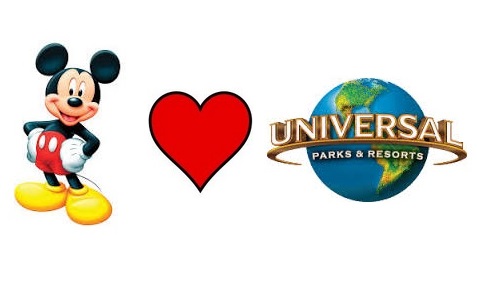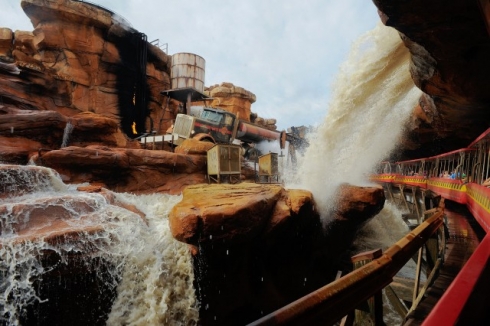
Disney has revealed that one of the opening day attractions at Disney’s Hollywood Studios, the Studio Backlot Tour, is to close in September 2014.
The move will come as no surprise to many, with the attraction having been designed to take guests on a tour of a real, working movie and television studio. Of course, Disney’s Hollywood Studios stopped being a major production center long ago – so the ride’s original purpose was largely lost.
In some ways, the loss of the attraction marks the final nail in the coffin of the decades-old dream to turn Orlando into “Hollywood East”. The story behind the Studio Backlot Tour is one of intense rivalry, lofty ambitions and – ultimately – failure to live up to those ambitions. Let’s take a look at how Walt Disney World’s latest defunct attraction came to be.
1. It could have been built by Disney AND Universal

As Disney established itself in Florida with the opening of Walt Disney World in 1971, Universal's then-owner MCA was looking on enviously. Even before Disney's resort opened its gates, the chairman of the board of its Recreation Services Group, Jay Stein, had mooted the idea of opening a studio tour in Florida, to capitalize on the influx of tourists heading to Disney’s property. Plans for Universal Studios Florida were shown to a number of potential financial backers in the early 1980s.
Disney CEO Michael Eisner was not one to take competition lying down. He announced plans for Disney-MGM Studios, hoping to kill Universal's park before it even got off the ground. MCA's CEO, Sidney Sheinberg, was similarly competitive and vowed to press on with the project.
Despite MCA’s bullish plans for Universal Studios Florida, the company did entertain the possibility of a truce with Disney. In June 1987, the firm's CEOs discussed whether the two companies' attractions could be combined into a single studios park. MCA offered to drop its plans, in exchange for a half-share in Disney-MGM Studios. Disney, though, was only willing to pay MCA a small royalty to use material from its films. MCA walked away.
2. Disney was accused of stealing its design

Universal's original plans for its Florida studios called for a "front lot" walking tour, as well as a tram tour through the studio's backlot. One set-piece, designed by Academy Award-winning art director Henry Bumstead, would see an enormous King Kong figure attack the tram as it passed over a New York bridge. Another, the "Hollywood Canyon", would see a tram rolling onto a bridge in view of the Hollywood Hills. A massive earthquake would then strike, causing a dam to crack and a wall of water to pour down towards the tram, which would escape into an oil field in time for riders to witness a semi-trailer truck explode after crashing into an oil tank.
The initial plans for Disney-MGM Studios, announced in 1985, bore a striking resemblance to those for Universal’s tour. The main attraction would be a tram tour past four working soundstages, an animation building, backlot sets and post-production facilities. One of the set pieces to be included in the tour would be “Catastrophe Canyon”, during which an earthquake would shake the tram, cause fires to ignite, lead to an oil tank explosion and trigger a flash flood. The similarities to Universal’s proposed Hollywood Canyon were undeniable.
3. It completely changed the design of Universal Studios Florida
Confronted with the knowledge that Disney-MGM Studios was likely to open its gates before Universal Studios Florida, MCA faced a dilemma. In Hollywood, it had established a successful business model with its studio and tour. However, with a tram tour being the headline attraction of Disney’s park, simply cloning the Universal Studios Hollywood experience in Florida would leave MCA open to accusations that it had copied Disney, and not vice-versa.
MCA decided to redesign the park from top to bottom, throwing out many of its original ideas. “We had to reprogram and repackage and rethink everything that we had originally contemplated,” said Universal's Jay Stein. “We really had to go back to ground zero.” In all marketing activities, MCA attempted to differentiate its park from Disney’s, stressing that Universal Studios Florida would be a very different proposition.
The core concept of a theme park built around a working movie studio was retained by MCA, meaning that some overlap with Disney’s offering was inevitable. However, the tram tour – the signature element of Universal Studios Hollywood – was dropped altogether from the plans for the Florida attraction, in response to Disney building its own version. Instead, the main set-pieces from the Hollywood tour, such as the encounters with Jaws and King Kong, would be blown up into separate, standalone attractions.

Comments
I guess even with the changes their was a tram in the early days of Universal Florida, that kind of just took you around the sound stages and not much else. It was really strange.